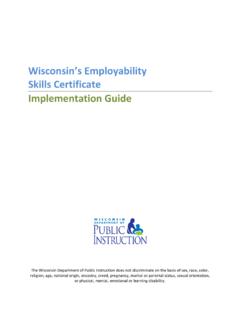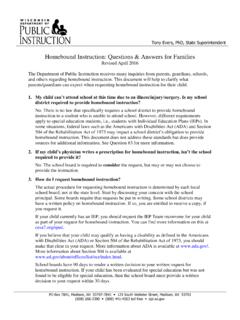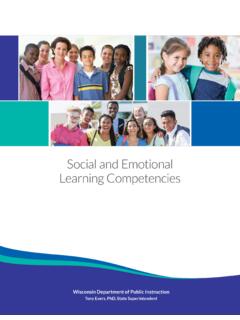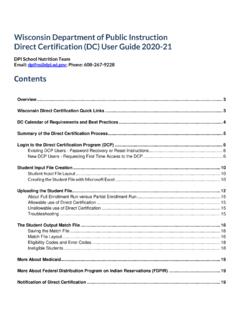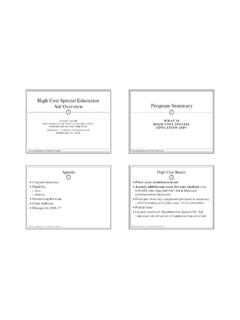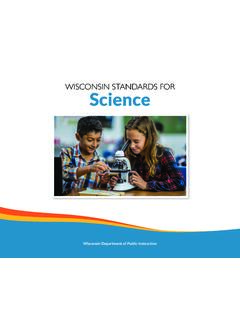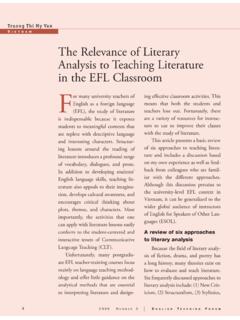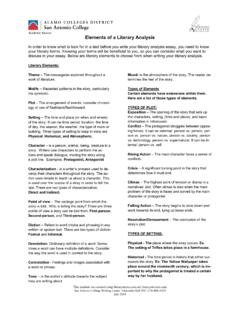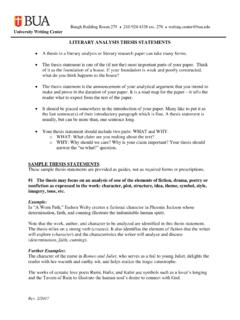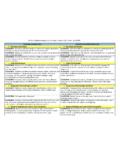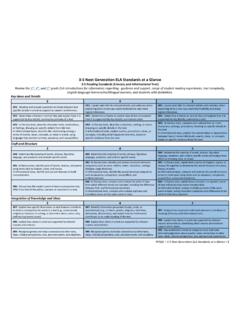Transcription of Text-Dependent Analysis Sampler
1 Grades 4. Text-Dependent Analysis Sampler Wisconsin Department of Public Instruction Jill K. Underly, PhD, State Superintendent i Wisconsin Forward Exam Text-Dependent Analysis Sampler Grade 4. Developed by The Wisconsin Department of Public Instruction Office of Student Assessment Adapted From The Pennsylvania Department of Education's Pennsylvania System of School Assessment English Language Arts Item and Scoring Sampler for 4th Grade Wisconsin Department of Public Instruction Jill K. Underly, PhD, State Superintendent Madison, Wisconsin This publication is available from: Office of Student Assessment Wisconsin Department of Public Instruction 125 South Webster Street Madison, WI 53703. January 2020 Wisconsin Department of Public Instruction The Wisconsin Department of Public Instruction does not discriminate on the basis of sex, race, color, religion, creed, age, national origin, ancestry, pregnancy, marital status or parental status, sexual orientation, or disability.
2 Acknowledgments Adapted from the Pennsylvania Department of Education's Pennsylvania System of School Assessment English Language Arts Item and Scoring Sampler for 4th Grade Copyrighted Materials Every effort has been made to ascertain proper ownership on copyrighted materials and to obtain permission for this use. Any omission is unintentional. One Lucky Fish passage and student samples used with permission of the Nebraska Department of Education. Copyright 2016 by the Nebraska Department of Education Living off the Earth passage and student samples used with permission of the Nebraska Department of Education. Copyright 2016 by the Nebraska Department of Education Hidden Kingdom passage and student samples used with permission of the Nebraska Department of Education. Copyright 2016 by the Nebraska Department of Education Excerpt from Trekking on a Trail: Hiking Adventures for Kids, copyright 2000 by Linda White.
3 Reprinted with permission of GIBBs SMITH, PUBLISHER via Copyright Clearance Center. The Greedy Dog Reprinted from Everything Fairy Tales Book by Amy Peters, copyright . 2001, F+W Media, Inc. Used by permission of Adams Media, an F+W Media, Inc. Co. All rights reserved. i ii Table of Contents Acknowledgments .. i Table of Contents .. iii Introduction .. 6. Overview .. 6. Connection to the Standards .. 6. Rubric and Scoring .. 7. Purpose and Uses .. 8. Professional Development .. 8. Improving Instruction .. 8. Student Practice and Test Preparation .. 8. Additional TDA Resources .. 9. Testing Time for the Forward Exam .. 9. Sample Items .. 10. Directions .. 10. Passage 1 .. 11. One Lucky Fish .. 11. Writer's Checklist for the Text-Dependent Analysis Question .. 13. Text-Dependent Analysis Question 1 .. 14. Text-Dependent Analysis Scoring Rubric.
4 15. Text-Dependent Analysis Sample Student Responses .. 17. Response Score 4 .. 17. Response Score 3 .. 20. Response Score 3 .. 22. Response Score 2 .. 24. Response Score 2 .. 26. Response Score 2 .. 28. Response Score 1 .. 30. Response Score 1 .. 32. Passage 2 .. 35. iii Living Off the Earth .. 35. Writer's Checklist for the Text-Dependent Analysis Question .. 37. Text-Dependent Analysis Question 2 .. 38. Text-Dependent Analysis Scoring Rubric .. 39. Text-Dependent Analysis Sample Student Responses .. 41. Response Score 4 .. 41. Response Score 3 .. 43. Response Score 3 .. 45. Response Score 2 .. 47. Response Score 2 .. 49. Response Score 2 .. 51. Response Score 2 .. 53. Response Score 2 .. 55. Response Score 1 .. 57. Response Score 1 .. 59. Passage 3 .. 61. Hidden Kingdom .. 61. Writer's Checklist for the Text-Dependent Analysis Question.
5 62. Text-Dependent Analysis Question 3 .. 63. Text-Dependent Analysis Scoring Rubric .. 64. Text-Dependent Analysis Sample Student Responses .. 66. Response Score 4 .. 66. Response Score 3 .. 68. Response Score 2 .. 70. Response Score 1 .. 72. Passage (set) 4 .. 75. The Greedy Dog .. 75. The Man and the Golden 78. Writer's Checklist for the Text-Dependent Analysis Question .. 79. Text-Dependent Analysis Question 4 .. 80. Text-Dependent Analysis Question Scoring Rubric .. 81. Text-Dependent Analysis Sample Student Responses .. 83. Response Score: 4 .. 83. Response Score: 4 .. 86. iv Response Score: 4 .. 88. Response Score: 3 .. 91. Response Score: 3 .. 93. Response Score: 3 .. 95. Response Score: 2 .. 97. Response Score: 2 .. 99. Response Score: 1 .. 101. Response Score: 1 .. 103. v Introduction Overview The English language arts (ELA) section of the Forward Exam includes a Text-Dependent Analysis (TDA) question.
6 A TDA requires students to use their best writing skills to compose an essay. Within the essay, the student must respond to a question and support their answer (claims, opinions, ideas) using evidence from the passage(s) read. The TDA allows students to demonstrate their ability to interpret the meaning behind the passage by writing an Analysis and providing supporting evidence. In order to successfully answer a TDA, students must demonstrate a deep understanding of the passage(s). thoroughly analyze passage(s) to support claims, opinions, and ideas. use a strong organizational structure with effective introduction, body, and conclusion paragraphs. reference the passage(s) using main ideas, details, examples, quotes, and/or facts as evidence. use precise language from the passage(s). use proper grammar and punctuation. Students will have up to 5,000 characters to formulate their response.
7 The TDA portion of the Forward Exam requires students to read the text and then respond in writing in one of several ways: identifying and explaining a theme or central idea, using textual evidence to support the claim about what that theme or central idea is, and analyzing the development of an event, character, central ideas, or theme, using textual evidence to support the explanation and Analysis . This document contains samples of TDA test questions, stimulus passages, and student responses. It is intended to be used as a guide for educators and students when preparing for the Forward Exam. Connection to the Standards Wisconsin's Academic Standards for English Language Arts (ELA) are divided into the four areas of reading, writing, speaking and listening, as well as language use. The ELA writing standards include a cluster of three standards called Text Types and Purposes which are: 1.
8 Write arguments to support claims in an Analysis of substantive topics or texts , using valid reasoning and relevant and sufficient evidence. 6. 2. Write informative/explanatory texts to examine and convey complex ideas and information clearly and accurately through the effective selection, organization, and Analysis of content. 3. Write narratives to develop real or imagined experiences or events using effective technique, well-chosen details, and well-structured sequences. The writing standards also include a cluster called Research to Build and Present Knowledge.. Standard 9 in this cluster is: draw evidence from literary or information texts to support Analysis , reflection, and research. The ELA reading standards include a cluster of three standards called Key Ideas and Details . which are: 1. Read closely to determine what the text says explicitly and to make logical inferences from it; cite specific textual evidence when writing or speaking to support conclusions drawn from the text.
9 2. Determine central ideas or themes of a text and analyze their development; summarize the key supporting details and ideas. 3. Analyze how and why individuals, events, and ideas develop and interact over the course of the text. Questions or prompts require students to prove their knowledge and abilities as stated in the above referenced reading and writing standards. Further, these prompts show that literacy is an integrated process where reading and writing (and speaking and listening and language use). are not separate skills, but work together. However, it is important to recognize that Forward Exam results on the TDA portion are reported as an assessment of purely the writing standards noted above. Rubric and Scoring The TDA is scored using a four point holistic rubric that measures writing skills and the student's ability to analyze and use information from the passage in order to develop a comprehensive essay.
10 The rubric is provided with each sample TDA in this document. Students may receive an initial score of 0-4. This score is then multiplied by 2 giving the student a final TDA score of 0, 2, 4, 6, or 8. Automated essay scoring or artificial intelligence (AI) scoring is used to score student responses to the TDA. AI scoring of essays is reliable when compared to traditional human scoring. Successful models rely heavily on accurately scored student responses from which the AI. training sets are derived. To develop the AI training sets, student responses are scored twice, independently, by DRC's professional hand scoring staff. Once a representative sample is scored, responses and corresponding scores are delivered to the AI team for model development. Using previously scored student responses, specialists create task specific algorithms that are used to accurately predict how humans would score these student responses.



